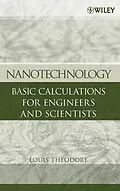A practical workbook that bridges the gap between theory and practice in the nanotechnology field
Because nanosized particles possess unique properties, nanotechnology is rapidly becoming a major interest in engineering and science. Nanotechnology: Basic Calculations for Engineers and Scientists-a logical follow-up to the author's previous text, Nanotechnology: Environmental Implications and Solutions-presents a practical overview of nanotechnology in a unique workbook format.
The author has developed nearly 300 problems that provide a clear understanding of this growing field in four distinct areas of study:
* Chemistry fundamentals and principles
* Particle technology
* Applications
* Environmental concerns
These problems have been carefully chosen to address the most important basic concepts, issues, and applications within each area, including such topics as patent evaluation, toxicology, particle dynamics, ventilation, risk assessment, and manufacturing. An introduction to quantum mechanics is also included in the Appendix. These stand-alone problems follow an orderly and logical progression designed to develop the reader's technical understanding.
"This is certain to become the pacesetter in the field, a text to benefit both students of all technical disciplines and practicing engineers and researchers."
-Dr. Howard Beim, Professor of Chemistry, U.S. Merchant Marine Academy
"Dr. Theodore has covered most of the important nanotechnology subject matter in this ...work through simple, easy-to-follow problems."
-John McKenna, President and CEO, ETS, Inc.
Autorentext
LOUIS THEODORE, Eng. Sc.D., is a consultant for Theodore Tutorials, a company specializing in providing training solutions to industry, academia, and government. In addition to receiving awards from both the International Air and Waste Management Association and the American Society for Engineering Education, Dr. Theodore is the author/coauthor of numerous books, including Nanotechnology: Environmental Implications and Solutions; Introduction to Hazardous Waste Incineration, Second Edition; and Handbook of Chemical and Environmental Engineering Calculations (all published by Wiley).
Inhalt
Preface xvii
Introduction xix
PART 1: CHEMISTRY FUNDAMENTALS AND PRINCIPLES 1
1 Units, Conversion Constants, and Dimensional Analysis 3
1.1 Background on the Metric System 4
1.2 Describe the SI System of Units 6
1.3 The Conversion Constant gc 9
1.4 Unit Conversion Factors: General Approach 10
1.5 Temperature Conversions 11
1.6 Pressure Calculations 11
1.7 Density and Thermal Conductivity 13
1.8 Viscosity Conversions 14
1.9 Air Quality Standard 14
1.10 Conversion Factors for Particulate Measurements 15
1.11 Significant Figures and Scientific Notation 15
1.12 Uncertainty in Measurement 17
2 Atoms, Elements, and the Periodic Table 19
2.1 Atomic Theory 21
2.2 The Avogadro Number 21
2.3 Mass and Size of Atoms 22
2.4 Atomic Conversions 23
2.5 Atomic Number, Atomic Weight, and Mass Number 24
2.6 Bismuth Application 24
2.7 Elements 24
2.8 Symbols for Elements 27
2.9 Periodic Table Application 28
2.10 Isotopes 29
3 Molecular Rearrangements 31
3.1 License Plate Sets 31
3.2 Chemical Permutations and Combinations 32
3.3 Formula Weight and Molecular Weight 34
3.4 Mole/Molecule Relationship 34
3.5 Pollutant Chemical Formulas 35
3.6 Stoichiometry 36
3.7 Limiting and Excess Reactants 36
3.8 Combustion of Chlorobenzene 37
3.9 Metal Alloy Calculation 39
3.10 Chemical Production 40
4 Concentration Terms 43
4.1 Density, Specific Gravity, and Bulk Density 43
4.2 Classes of Solution 45
4.3 Molality versus Molarity 45
4.4 Molar Relationships 46
4.5 Concentration Conversion 47
4.6 Chlorine Concentration 48
4.7 Trace Concentration 49
4.8 Ash Emission 50
4.9 Dilution Factor 51
4.10 Nano Exhaust to Atmosphere 52
4.11 Flue Gas Analysis 52
4.12 pH 53
5 Particle Size, Surface Area, and Volume 55
5.1 Sphere, Cube, Rectangular Parallelepiped, and Cylinder 56
5.2 Parallelogram, Triangle, and Trapezoid 57
5.3 Polygons 57
5.4 Elipse and Ellipsoid 58
5.5 Cones 58
5.6 Torus 59
5.7 Area to Volume Ratios 59
5.8 Area to Volume Calculation 60
5.9 Increase in Sphere Surface Area 60
5.10 Increase in Cube Surface Area 61
6 Materials Science Principles 63
6.1 Metals, Polymers, and Ceramics 63
6.2 Composites, Semiconductors, and Biomaterials 64
6.3 Crystal Coordination Numbers 64
6.4 Geometry of Metallic Unit Cells 70
6.5 Geometry of Ionic Unit Cells 75
6.6 Packing Factor 78
6.7 Density Calculation 80
6.8 Directions and Planes 83
6.9 Linear Density 88
6.10 Planar Density 90
7 Physical and Chemical Property Estimation 95
7.1 Property Differences 96
7.2 Material Selection 97
7.3 Vapor Pressure 97
7.4 Vapor Pressure Calculation 98
7.5 Heat of Vaporization From Vapor Pressure Data 99
7.6 Critical and Reduced Properties 100
7.7 Estimating Enthalpy of Vaporization 101
7.8 Viscosity 104
7.9 Thermal Conductivity 106
7.10 Thermal Conductivity Application 108
7.11 Nokay Equation and Lydersen's Method 109
7.12 The Rihani and Doraiswamy Procedure, and the LeeKesler Equation 113
References: Part 1 117
PART 2: PARTICLE TECHNOLOGY 119
8 Nature of Particulates 121
8.1 Definition of Particulates 121
8.2 Dust, Smoke, and Fumes 122
8.3 Mist and Drizzle 123
8...
